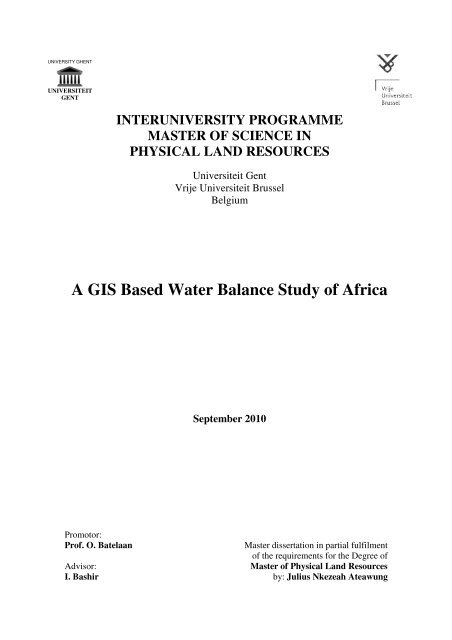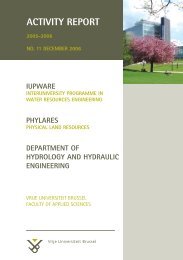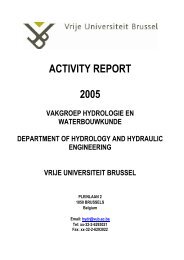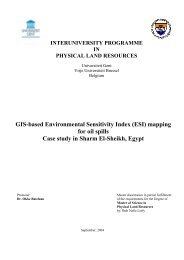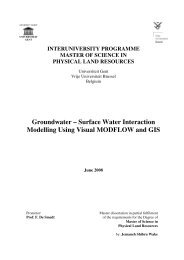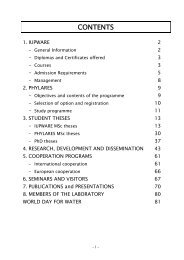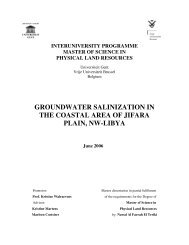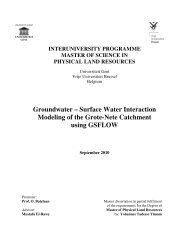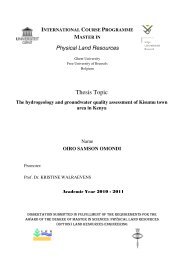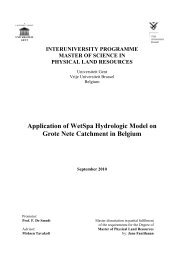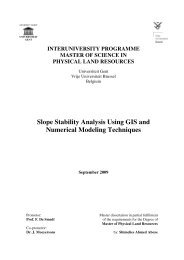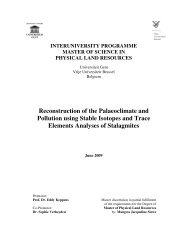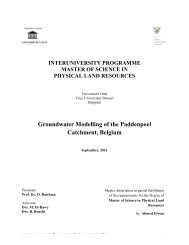A GIS Based Water Balance Study of Africa - Physical Land Resources
A GIS Based Water Balance Study of Africa - Physical Land Resources
A GIS Based Water Balance Study of Africa - Physical Land Resources
Create successful ePaper yourself
Turn your PDF publications into a flip-book with our unique Google optimized e-Paper software.
4LIST OF FIGURESFigure 1.1: Flowchart <strong>of</strong> research methodology---------------------------------------------------------9Figure 1.2: Schematic water balance <strong>of</strong> a hypothetical raster cell------------------------------------14Figure 3.1: Topographic map <strong>of</strong> <strong>Africa</strong>-------------------------------------------------------------------23Figure 3.2: Slope map <strong>of</strong> <strong>Africa</strong>---------------------------------------------------------------------------24Figure 3.3: USDA-based reclassified Soil map <strong>of</strong> <strong>Africa</strong> ---------------------------------------------25Figure 3.4: Histogram <strong>of</strong> soil texture classes------------------------------------------------------------25Figure 3.5: <strong>Land</strong>use map <strong>of</strong> <strong>Africa</strong>------------------------------------------------------------------------26Figure 3.6: Histogram <strong>of</strong> regrouped landuse classes for WetSpass-----------------------------------27Figure 3.7 Histogram <strong>of</strong> relative proportion <strong>of</strong> <strong>Land</strong>use classes--------------------------------------27Figure 3.8 Annual rainfall map <strong>of</strong> <strong>Africa</strong>-----------------------------------------------------------------28Figure 3.9 PET map <strong>of</strong> <strong>Africa</strong>------------------------------------------------------------------------------30Figure 4.1: Average annual evapotranspiration values from WetSpass-----------------------------34Figure 4.2: Annual average evapotranspiration values-------------------------------------------------35Figure 4.3: Average annual evapotranspiration values across <strong>Africa</strong> --------------------------------36Figure 4.4: Annual average trend <strong>of</strong> surface run<strong>of</strong>f values across <strong>Africa</strong>----------------------------37Figure 4.5: Annual run<strong>of</strong>f trends --------------------------------------------------------------------------38Figure 4.6: Groundwater recharge map <strong>of</strong> <strong>Africa</strong>-------------------------------------------------------40Figure 4.7: Groundwater recharge map <strong>of</strong> <strong>Africa</strong> (From Döll et al. 2002) --------------------------41Figure 4.8: Interception map <strong>of</strong> <strong>Africa</strong>--------------------------------------------------------------------42Figure 4.9: Surface evaporation map <strong>of</strong> <strong>Africa</strong>----------------------------------------------------------43Figure 4.10: Transpiration map <strong>of</strong> <strong>Africa</strong> ----------------------------------------------------------------44
5LIST OF TABLESTable 3.1: Summary <strong>of</strong> annual minimum, maximum and mean values <strong>of</strong> precipitation ----------29Table 3.2: Summary <strong>of</strong> PET values on a seasonal and annual base-----------------------------------30Table 3.3: Statistical values <strong>of</strong> seasonal and annual temperature values-----------------------------31Table 4.1: Summary <strong>of</strong> previously computed water balance values <strong>of</strong> <strong>Africa</strong> ----------------------47Table 4.2: Summary <strong>of</strong> computed water balance components----------------------------------------50
6SUMMARYNkezeah, A.J., 2010. A <strong>GIS</strong> <strong>Based</strong> <strong>Water</strong> <strong>Balance</strong> <strong>Study</strong> <strong>of</strong> <strong>Africa</strong>. M.Sc Thesis, VrijeUniversiteit Brussel, Belgium, 55pp.The <strong>GIS</strong>-based water balance Model WetSpass was applied to the continent <strong>of</strong> <strong>Africa</strong> toinvestigate the amount and variability <strong>of</strong> annual water balance components for an area <strong>of</strong>approximately 30 million Sq. Km. Average annual spatial patterns <strong>of</strong> surface run<strong>of</strong>f, actualevapotranspiration and ground water recharge were computed. Gridded 1km spatial resolutionmaps <strong>of</strong> elevation, soil, landuse/landcover, slope, and climatological variables were used. Theresults show variability in water balance components across the continent. These changescorrelate with local and regional changes <strong>of</strong> the parameters above.Estimates <strong>of</strong> Evapotranspiration (ET) go beyond 1000mm/yr around equatorial <strong>Africa</strong>. The aridregions <strong>of</strong> the Sahara and the western tip <strong>of</strong> southern <strong>Africa</strong> fall below 100mm/yr. In the semiarid subtropics <strong>of</strong> southern <strong>Africa</strong> the value ranges between 200 to 700mm/yr. Very little or nosurface run<strong>of</strong>f occurs around the northern Sahel except for the mountainous areas further northwest with values <strong>of</strong> 10-50mm/yr. Higher values <strong>of</strong> 100-400mm/yr occur around the ruggedterrain <strong>of</strong> east <strong>Africa</strong>. The groundwater recharge estimates are higher around the humid regions<strong>of</strong> the tropics than further north and south. This obviously is related to higher amounts <strong>of</strong> rainfallthat this region receives annually.Generally there is a good agreement between the calculations <strong>of</strong> this study and others that havebeen carried out with other approaches/ methods e.g. Nicholson et al. (1997). The average annualsurface run<strong>of</strong>f for <strong>Africa</strong> is computed at 57mm/yr, ET 588mm/yr, groundwater recharge34mm/yr. interception 104mm/yr, transpiration 383mm/yr and soil evaporation 72mm/yr.While these values are not exact but only estimates, they do provide useful insights on thevariability <strong>of</strong> these critically important water balance components across the continent.
7CHAPTER 1INTRODUCTION1.1. GENERAL INTRODUCTION<strong>Water</strong> is a resource <strong>of</strong> critical importance for sustaining life on this planet. In <strong>Africa</strong> especially,where a greater part <strong>of</strong> the population depend on agriculture as a source <strong>of</strong> livelihood, theimperative to properly manage water resources has become even more demanding. The rapidpopulation growth and climatic changes throughout the continent in recent years have furtherhighlighted this concern.While there is a growing demand for water resources in <strong>Africa</strong>, there is limitation to currentmanagement arising from amongst others lack <strong>of</strong> sufficient knowledge about the resource. Theestimation and quantification <strong>of</strong> hydrologic parameters such as surface run<strong>of</strong>f, actualevapotranspiration and ground water recharge are key factors to the sustainable management <strong>of</strong>water resources. Unfortunately, parameters such as evapotranspiration or run<strong>of</strong>f are rarelymeasured directly (Nicholson et al., 1997). The few measurements that are available are at localor basin scale and out <strong>of</strong> scale with the current reality. Evapotranspiration is generally calculatedfrom empirical formulas or energy balance approaches. Run<strong>of</strong>f is usually calculated as aresidual. The problem for <strong>Africa</strong> is the general lack <strong>of</strong> data for continental scale comparisons <strong>of</strong>water cycle studies.With the advent <strong>of</strong> Geographic Information Systems (<strong>GIS</strong>), physical-based hydrologic modelinghas become important in contemporary hydrology for assessing these parameters as well as theimpact <strong>of</strong> human intervention and/or possible climatic change on basin hydrology and waterresources (Alemaw and Chaoka, 2003). Information gathered from these models can greatlyenhance the decision making process in these regions. Unfortunately, poor knowledge aboutthese technologies in addition to the expensive nature <strong>of</strong> some <strong>GIS</strong> s<strong>of</strong>tware packages hasretarded progress on the Continent as a whole. However, most Governments have begundedicating many resources in acquiring these s<strong>of</strong>tware and hardware packages for researchpurposes. This research is partly motivated by these policy changes.
81.2. OBJECTIVE OF THE RESEARCHThe specific objectives <strong>of</strong> this research are threefold:1. To estimate in quantitative terms the annual average water balance components (surfacerun<strong>of</strong>f, actual evapotranspiration, groundwater recharge, soil evaporation etc) for theentire continent <strong>of</strong> <strong>Africa</strong> using a <strong>GIS</strong>-based approach.2. To present a general overview <strong>of</strong> the variability <strong>of</strong> these components across <strong>Africa</strong>.3. To demonstrate that despite the general lack <strong>of</strong> hydrological datasets on the continentresearch on the water cycle is still possible with the few data available.
91.3. REPORT OVERVIEWFigure 1.1 shows a 4-stage summary <strong>of</strong> the steps followed to undertake this thesis.GENERAL STEPS- state problem- state researchobjectivesACTIVITY PROCEDURES / PRODUCTSINVOLVED- review literature - discuss with promoter & advisor- read journals & books- discuss with peers- build spatial datasets - search maps- download maps- topography- soil- temperature- precipitation, etc- process spatial data -modify data tomodel compatibleformat- analyze spatial data -set up WetSpass-run model- Grids <strong>of</strong>:- landuse- soil- topography- slope etc- report results- make conclusions- make recommendationsFigure 1.1: Flowchart <strong>of</strong> research methodology
101.4. ORGANISATION OF THE REPORTThis report has been organized into 5 chapters. Chapter 1 is a general introduction that outlinesthe research objectives and gives an overview <strong>of</strong> the methodology.Chapter 2 is a presentation <strong>of</strong> the review <strong>of</strong> some consulted literature on <strong>GIS</strong>-based hydrologicalmodelling. It includes details <strong>of</strong> the WetSpass methodology employed in the analysis <strong>of</strong> the datafor this research.Chapter 3 deals with the materials and methods.Chapter 4 is a presentation <strong>of</strong> the results <strong>of</strong> the analysis accompanied by some discussion.Finally the report ends with chapter 5 which draws some conclusions and recommendations.
11CHAPTER 2LITERATURE REVIEW2.1. <strong>GIS</strong>-BASED HYDROLOGICAL MODELLING<strong>GIS</strong> is a system <strong>of</strong> hardware, s<strong>of</strong>tware and procedures designed to support the capture,management, manipulation, analysis, modeling and display <strong>of</strong> spatially referenced data forsolving complex planning and management problems (Rhind, 1989).Owing to its sophisticated analysis and graphic capabilities, <strong>GIS</strong> has become a powerful tool inhydrological modeling. Almoutaz (2002) highlights some <strong>of</strong> its capabilities to include the abilityto:• Make the information in the data base available in the same screen during datapreparation.• Save and analyze spatial data and results as any <strong>GIS</strong> layers.• Provide a graphical error check in continuous bases.• Integrate data layers and performs spatial operations on data in a flexible manner.Some random citing is made <strong>of</strong> some <strong>GIS</strong>-based water balance modelling approaches.Jyrkama et al. (2002) developed a methodology for incorporating the hydrologic model HELP3to generate a physically based and highly detailed recharge boundary condition for groundwatermodelling. The model uses daily precipitation and temperature records in addition to landuse/landcover and soil data.Stone et al. (2001) used a method that involves the combination <strong>of</strong> <strong>GIS</strong> analysis, empiricalsurface run<strong>of</strong>f modelling and water balance calculations to estimate the groundwater rechargewithin the hydrographic basins in the Great Basin region <strong>of</strong> the South West United States.
14independent water balances. Thus the total water balance <strong>of</strong> a given area is calculated as asummation <strong>of</strong> the water balances <strong>of</strong> each raster cell as shown by the following equations.ET raster = a v ET v + a s E s + a o E o + a i E i (2.1)S raster = a v S v + a s S s + a o S o + a i S i (2.2)R raster = a v R v + a s R s + a o R o + a i R i (2.3)Where ET raster , S raster , R raster are the total evapotranspiration, surface run<strong>of</strong>f, and groundwaterrecharge <strong>of</strong> a raster cell respectively, each having a vegetated, bare-soil, open-water andimpervious area component denoted by a v , a s , a o , and a i , respectively.
16dependency on soil and vegetation type. In the second step, actual surface run<strong>of</strong>f is calculatedfrom the S v-pot by considering the differences in precipitation intensities in relation to soilinfiltration capacitiesS v =C Hor S v – pot (2.6)Where, C Hor is a coefficient that parameterizes the fraction <strong>of</strong> seasonal precipitation contributingto the Hortonian overland flow. For groundwater discharge areas C Hor is equal to 1 since allintensities <strong>of</strong> precipitation contribute to surface run<strong>of</strong>f. On the other hand, only high intensitystorms can generate surface run<strong>of</strong>f in infiltration areas.EVAPOTRANSPIRATIONThis refers to the sum <strong>of</strong> evaporation and plant transpiration from the Earth's land surface toatmosphere. Evaporation accounts for the movement <strong>of</strong> water to the atmosphere from sourcessuch as the soil, canopy interception, and water bodies. Transpiration accounts for the movement<strong>of</strong> water within a plant and the subsequent loss <strong>of</strong> water as vapor through stomata in its leaves.In order to obtain a seasonal distributed evapotranspiration value, WetSpass converts the openwater evaporation value to a reference transpiration value ( Federer, 1979) based on a vegetationcoefficient.T rv = cE o (2.7)Where, T rv is the reference transpiration <strong>of</strong> a vegetated surface [LT -1 ]E o is the potential evaporation <strong>of</strong> open water [LT -1 ], and
17c is the vegetation coefficient [-].The vegetation coefficient (c) is determined as the ratio <strong>of</strong> the reference vegetation transpirationas given by the Penman-Monteith equation.1+γc = Λ⎛ r+⎜ +c1γ1Λ⎝ ra⎞⎟⎠(2.8)Where, γ is the psychrometric constant [ML -1 T -2 C -1 ]Λ , is the slope <strong>of</strong> the first derivative <strong>of</strong> the saturated vapour pressure curve (slope <strong>of</strong> saturatedvapour pressure at the prevailing air temperature) [ML -1 T -2 C -1 ]r c is the canopy resistance [TL -1 ] andr a is the aerodynamic resistance [TL -1 ] and given by the equation:2r 1 ⎡ z ⎤a− da= ln2 ⎢ ⎥k ua⎣ z(2.9)o ⎦Where k is the Von Karman constant = 0.4 [-]u a is the wind speed [LT -1 ] at the measurement level z a = 2md is the zero plane displacement length [L], and
18z 0 is the roughness length for the vegetation or soil [L]For vegetated recharge areas, the actual transpiration (T v ) is equal to the reference transpirationdue to the reason that the availability <strong>of</strong> soil water is not limiting.T v = T rv if (G d –h t ) ≤ R d (2.10)Where G d is groundwater depth [L], h t is the tension saturated height [L], and R d is the rootingdepth [L].For a vegetated area where the groundwater level is below the root zone the actual transpirationis given by:T v = f(θ)T rv if (G d - h t ) > R d (2.11)f(θ) is a function <strong>of</strong> the water content. For a time variant simulation it is defined as:f (θ) = 1- a 1w/Trvwith w = P + ( θ fc - θ pwp )R d (2.12)Where a 1 is the calibrated parameter related to sand content <strong>of</strong> a soil [-], w is the water availablefor transpiration [LT -1 ], and θ fc - θ pwp is the plant available water content [T -1 ] and stated as thedifference in water content at field capacity and at permanent wilting point.
19GROUNDWATER RECHARGERecharge refers to the process where water moves downward from surface water to groundwater(vadose) zone below plant roots. WetSpass calculates groundwater recharge as a residual term<strong>of</strong> the water balance. That is:R v = P-S v - ET v -I (2.13)ET v is the actual evapotranspiraton [LT -1 ] given as the sum <strong>of</strong> transpiration T v and E s (theevaporation from the bare soil in between the vegetation)By applying the above equations and relations spatially distributed recharge can thus beestimated from the vegetation type, soil type, slope, groundwater depth, precipitation, potentialevapotranspiration, temperature and wind speed.WATER BALANCE FOR BARE SOIL, OPEN WATER AND IMPERVIOUS SURFACESRecharge is estimated from the water balance for bare soil as:P = S s + E s + R s (2.14)Where P is the precipitation , S s, is the surface run<strong>of</strong>f, E s is the actual evapotranspiration, and R s isthe groundwater recharge. All have the unit [LT- 1 ] Equation (2.14) is the same as Equation (2.4)except that there is no interception and transpiration term. The ET v in this case becomes E s . Thesurface run<strong>of</strong>f is simulated in a similar way to the vegetated area fraction in two stages. In the
20first stage, the potential surface run<strong>of</strong>f, S v – pot , is calculated and in the second stage, the actualsurface run<strong>of</strong>f is calculated using Equation (2.6)The water balance for the open water fraction <strong>of</strong> a pixel is defined as:P = S o + E o + R o (2.15)Where P is the precipitation, E o is the evaporation from the water surface, S o is the part <strong>of</strong>precipitation that runs over the water surface and R o is the groundwater recharge from openwater and all have unit <strong>of</strong> [LT -1 ]Finally the water balance for impervious surfaces is also given by:P = S i + E i + R i (2.16)Where the index i refer to the impervious surfaces.
21CHAPTER 3MATERIALS AND METHODS3.1. DESCRIPTION OF STUDY AREA<strong>Africa</strong> is the second largest continent after Asia covering a total surface area <strong>of</strong> about 30.2million km 2 (11.7 million sq miles) (Wikipedia, 2010). The study area is bounded by Longitudes-17.5 o W and 51.5 o E and Latitudes 37.4 o N and -34.8 o S. For reasons <strong>of</strong> lack <strong>of</strong> complete data theIsland region <strong>of</strong> Madagascar was masked out. <strong>Africa</strong>’s relief is characterized by two broadelevated regions <strong>of</strong> eastern and southern <strong>Africa</strong> having an average topography <strong>of</strong> 1015m (asl)while a more subdued low-lying area dominates the central western region with an averageelevation <strong>of</strong> 450m (asl). Both regions are punctuated in places by elevated areas <strong>of</strong> about 2000-5000m e.g. Mt Cameroon (4095m) and Mt Kilimanjaro (5893m). <strong>Africa</strong> straddles the equatorand encompasses numerous climate areas. The central region has a tropical rain forest climate.Here, the average annual temperature is about 26.7° C and the average annual rainfall is about1780 mm/yr. The north and south <strong>of</strong> the equator is characterized by a drier steppe climate zonehaving an average annual rainfall between 250 and 500mm/yr. The arid regions such as theSahara in the north, the Horn <strong>of</strong> <strong>Africa</strong> in the east, and the Kalahari and Namib deserts in thesouthwest have less than 250 mm <strong>of</strong> rainfall annually.Regions <strong>of</strong> tropical <strong>Africa</strong> located north <strong>of</strong> the equator experience the rainy season from April-September and the dry season from October-March while those south <strong>of</strong> the equator experiencethe rainy season from October-March. The dry season occurs from April-September. Potentialevapotranspiration which is the combined evaporation from the soil surface and transpirationfrom plants when the water supply is unlimited ranges averagely from 400-1400 on an annualscale (Balek, 1979).
223.2. DRAINAGE AND HYDROGEOLOGY<strong>Africa</strong> has a vast array <strong>of</strong> drainage networks. Amongst the major ones are the river Nile whichdrains northeast and empties into the Mediterranean Sea. The Congo River drains much <strong>of</strong>central <strong>Africa</strong> and empties into the Indian Ocean. Southern <strong>Africa</strong> is drained by the ZambeziRiver. Lake Chad constitutes one <strong>of</strong> the largest inland drainage areas <strong>of</strong> the continent. Othermajor lakes located in the east <strong>of</strong> <strong>Africa</strong> include Lake Tanganyika and Lake Victoria.The geological structure <strong>of</strong> <strong>Africa</strong>, with lowlands in the north, central and western regions andhighlands in the east and south, contributes to the uniformity <strong>of</strong> the groundwater regimes on thecontinent. Generally, large water-bearing units correspond to large geological bodies.Precambrian formations at low attitudes in West <strong>Africa</strong> and the high altitudes <strong>of</strong> the East <strong>Africa</strong>nhighlands have water bearing aquifers in weathered, fractured or combined sections. Aquifers <strong>of</strong>the calcero-dolomitic and limestone-shale series are found south <strong>of</strong> the equator and parts <strong>of</strong> West<strong>Africa</strong>. The large sedimentary basins <strong>of</strong> central <strong>Africa</strong> are filled with s<strong>of</strong>t deposits <strong>of</strong> Paleozoic,Jurassic and cretaceous origin (Balek, 1979). In the Sahel region intermediate and deep aquifersare found in the continental sandstones.3.3. THE INPUT DATAThis study was performed using the WetSpass model whose detail methodology is explainedabove (2.2). The model uses a combination <strong>of</strong> both gridded files and parameter tables (dbf files).Arcview (version 3.2) together with its spatial analyst extensions were used to process all <strong>of</strong> theinput data. The model was applied to the study area using grid cells <strong>of</strong> 1km x 1km spatialresolution. WetSpass operates on the bases <strong>of</strong> two seasonal datasets (winter and summer). Theyear was divided into two seasons with summer months running from April to September andwinter from October to March. Each season requires a separate gridded file <strong>of</strong> landuse,precipitation, potential evapotranspiration, wind speed, temperature, and groundwater depth. Themodel also uses separate dbf attribute tables for soil, landuse, and run<strong>of</strong>f coefficients. Due to thelack <strong>of</strong> monthly data for landuse, wind speed and groundwater depth, same maps were used asinput for both seasons. This <strong>of</strong> course makes assumption to the fact that these parameters stay thesame during both seasons. The following data sets were used as input to the model.
233.3.1. TOPOGRAPHY AND SLOPEThe topographical data used in this study for characterizing the horizontal hydrologicalcharacteristics <strong>of</strong> the land surface are derived from the HYDRO1k geographic databasedeveloped by the US Geological Survey's EROS Data Center in cooperation with the UnitedNations Environment Programme/Global Resource Information Database (UNEP/GRID) locatedin Sioux Falls, South Dakota USA. The slope data layer describes the maximum change in theelevations between each cell and its eight neighbors. The slope is expressed in integer degrees <strong>of</strong>slope between 0 and 90.The elevation <strong>of</strong> the study area varies from below sea level to 5825m above sea level. Theaverage is approximately 651m (Fig 3.1). The slope varies from 0 to 44 percent with average0.80 percent (Fig 3.2).30° 30° 30° 10° 10° 30° 50° 70°10° 10°10° 10°Topography(m)Below sea level0 - 100100 - 250250 - 500500 - 10001000 - 15001500 - 20002000 - 2500>2500No DataNWE3000 0 3000 6000 MilesSFigure 3.1: Topographic Map <strong>of</strong> <strong>Africa</strong>30° 30° 10° 10° 30° 50° 70° 30°
30° 30° 30° 10° 10° 30° 50° 70°10° 10°24Slope <strong>of</strong> Topography0 - 0.5 ( % )0.5 - 11 - 1.51.5 - 22 - 55 - 77 - 10>10No DataNWE3000 0 3000 6000 MilesS10° 10°Figure 3.2: Slope Map <strong>of</strong> <strong>Africa</strong>30° 30° 10° 10° 30° 50° 70° 30°3.3.2. SOILThe soil map <strong>of</strong> major soil types in the area <strong>of</strong> study came from the United Nations’ FAO1.5,000,000 Digital Soil Map <strong>of</strong> the World. The soil code system that WetSpass uses is based onthe soil texture triangle developed by the United States Department <strong>of</strong> Agriculture (USDA).USDA soil classification takes into account the percentages <strong>of</strong> clay, silt and sand in the soil.Soils dominated by fine textures are classified as clay. Those with intermediate textures loam,coarse texture soils are sand. The original soil map consisting <strong>of</strong> 4904 soil classes based on FAOnomenclature were reclassified to the USDA soil system (Fig 3.3). We must admit here thaterrors <strong>of</strong> misclassification could have occurred during this painstaking and laborious process,however, without undermining one’s determination to achieve maximum accuracy the outcome<strong>of</strong> such minor error will be minimal taking into account the 1km by 1km pixel size. The soil
25textural types were dominated by loam followed by sandy loam and sand in decreasing order(Fig 3.4).30°10°10°30° 30°10° 10°10° 10°30°50°70°Soil_reclasssandloamy sandsandy loamsilty loamloamsandy clay loamclay loamsilty clayclayNo DataNWE3000 0 3000 6000 MilesSFigure 3.3: USDA-based Soil Classification Map <strong>of</strong> <strong>Africa</strong>30° 30° 10° 10° 30° 50° 70° 30°Figure 3.4: Histogram plot <strong>of</strong> the soil classes in the catchment (x-axis = pixel number)
263.3.3. LANDUSE/LANDCOVER<strong>Land</strong> use information is an important input to the WetSpass model because each landuse typecontributes differently to the simulated output. For example there are variations in leave areaindexes and rooting depths from one type <strong>of</strong> vegetation to the next. Therefore, one would expectthe simulated outcome to vary with respect to these changes. The landuse/ landcover map wasobtained from the United States Geological Survey (http://edc2.usgs.gov/glcc/afdoc1_2.php).The data is a 1-km nominal spatial resolution map which is based on 1-km AVHRR dataspanning April 1992 through March 1993. The landuse / landcover classes are grouped intonineteen (Fig 3.5). WetSpass classes distinguish from each other on the basis <strong>of</strong> their effect onhydrological processes. The nineteen classes were therefore reclassified into one <strong>of</strong> fivedominant classes namely Grass, Forest, Crop, Bare soil and Open water (Fig 3.6). Each <strong>of</strong> theseclasses is characterized by quantitative attributes for vegetated, impervious, bare and open waterareas that sum up to one.30°10°10°30° 30°10° 10°10° 10°30°50°70°<strong>Land</strong>useurban/buidup landdryland/cropland/pasturecropland/pasturecropland/grasslandcropland/wetlandgrasslandshrublandshrubland/grasslandsavanadeciduous broadleaf forestevergreen broad leaf forestevergreen needleleaf forestmixed forestwater bodiesherbaceous w etlandwooded wetlandbarren/sp arsely vegetatedNo DataNWE2000 0 2000 4000 MilesSFigure 3.5: <strong>Land</strong>use/ <strong>Land</strong>cover Map <strong>of</strong> <strong>Africa</strong>.30° 30° 10° 10° 30° 50° 70° 30°
283.3.4 PRECIPITATION INPUT DATAThe precipitation data used for this study are based on the Rainfall Estimate (RFE) imagesprepared by the National Oceanic and Atmospheric Administration’s (NOAA) climate predictioncenter for the United States Agency for International Development (USAID) Faming earlyWarning System (FEWS). The images are archived and disseminated by USGS(http://earlywarning.usgs.gov/adds/index.php). They are compiled on a nominal 10 day time stepfrom thermal infra red images from Meteosat, acquired every 30 minutes. Each month iscomposed <strong>of</strong> 3 maps. These were added up to construct a single map for each month <strong>of</strong> the year.The compilations were done for a period <strong>of</strong> 3 years (2007-2009). The maps were then resampledfrom their initial 8km x 8km resolution to 1km x 1km. The average annual precipitation for<strong>Africa</strong> from 2007-2009 is presented in Fig 3.8. Table 2 shows a summary statistics <strong>of</strong>precipitation values.30° 30° 30° 10° 10° 30° 50° 70°10° 10°10° 10°(mm)Rainfall_yrly1 - 100100 - 500500 - 10001000 - 15001500 - 2000>2000No DataNWE3000 0 3000 6000 MilesSFigure 3.8: Mean annual Rainfall Map <strong>of</strong> <strong>Africa</strong> (2007-2009)30° 30° 10° 10° 30° 50° 70° 30°
29Table 3.1 Summary <strong>of</strong> annual minimum, maximum and mean values <strong>of</strong> PrecipitationPrecipitation (mm)SeasonMinimum Maximum AverageWinter 0 1606 317Summer 0 2633 354Annual 0 3667 6713.3.5 POTENTIAL EVAPOTRANSPIRATION (PET)PET is a measure <strong>of</strong> the ability <strong>of</strong> the atmosphere to remove water through the process <strong>of</strong>evaporation and transpiration. The FAO introduced the definition <strong>of</strong> PET as theevapotranspiration <strong>of</strong> a reference crop under optimal conditions, having the characteristics <strong>of</strong>well watered grass with an assumed height <strong>of</strong> 12 centimeters, a fixed surface resistance <strong>of</strong> 70seconds per meter and an albedo <strong>of</strong> 0.23 (Allen et al. 1998). Among several equations to estimatePET, the FAO application <strong>of</strong> the Penman-Monteith equation (Allen et al. 1998), is currentlywidely considered as a standard method (Walter et al. 2000). Data on referenceevapotranspiration used for this study is available from the Consortium for Spatial Information(CGIAR-CSI) Global Aridity Index (Global-Aridity) and Global Potential Evapotranspiration(Global-PET) Climate Database. The dataset is a representation <strong>of</strong> monthly average Potentialevapotranspiration estimates covering the period 1950-2000. It is distributed through theCGIAR-CSI GeoPortal (http://www.csi.cgiar.org). Fig 3.9 and Table 3.2 respectively show theaverage annual potential evapotranspiration map and some statistical values.
30° 30° 30° 10° 10° 30° 50° 70°10° 10°30(mm)Pet_annual0 - 100100 - 500500 - 10001000 - 15001500 - 20002000 - 3000No DataNWE3000 0 3000 6000 MilesS10° 10°Fig 3.9: Map <strong>of</strong> annual average Potential Evapotranspiration <strong>of</strong> <strong>Africa</strong>30° 30°10° 10° 30° 50° 70°Table 3.2 Summary <strong>of</strong> PET values on a seasonal and annual base30°PET (mm)SeasonMinimum Maximum AverageWinter 223 1285 874Summer 202 1463 971Annual 449 2383 1845
313.3.6. TEMPERATURETemperature maps were obtained from the online directory <strong>of</strong> spatial information maintained byUnited Nations Environment Programme (http://geodata.grid.unep.ch/). The data representestimates <strong>of</strong> monthly minimum and maximum temperatures for the period running from 1950-2000. Processing <strong>of</strong> these temperature images involved summing together the minimum andmaximum temperatures then taking an average between them. A presentation <strong>of</strong> derived statistics<strong>of</strong> the temperature data is shown on Table 3.3.Table 3.3 Statistical values <strong>of</strong> seasonal and annual temperatureTemperature ( o C)SeasonMinimum Maximum AverageWinter -5 30 21Summer -7 34 24Annual -6 29 223.3.7 DBF PARAMETER TABLES<strong>Land</strong>use, parameter tables were prepared similar to that <strong>of</strong> Batelaan and Woldeamlak (2003).Each <strong>of</strong> the 19 landuse/landcover type were re-assigned as either crop, forest, grass, baresoil oropen water and given numerical IDs from 1-5 (Fig 3.6) . The table also contain values for rootingdepth, leaf area index and vegetation height. The soil attribute table and run<strong>of</strong>f coefficient <strong>of</strong>Batelaan and Woldeamlak were used after modification to tie with our data.
32CHAPTER 4RESULTS AND DISCUSSION4.1. INTRODUCTIONIn addition to computing the long-term average spatially distributed recharge <strong>of</strong> a basin,WetSpass also simulates the following out put on both seasonal and annual basis:- Evapotranspiration- Run<strong>of</strong>f- Interception- Transpiration- Soil evaporation, and- Error in water balance.Annual variations <strong>of</strong> actual evapotranspiration, run<strong>of</strong>f, groundwater recharge, soil evaporation,interception and transpiration across the continent will be highlighted and the results comparedwith those <strong>of</strong> previous researchers on the subject. A tabular summary <strong>of</strong> the seasonal values willalso be presented.4.2. YEARLY RESULTSThe simulation process took approximately 5-6 hours to complete. The following yearly out putmaps were produced:4.2.1. EVAPOTRANSPIRATION (ET)ET is a key factor in water balance computations. The surface <strong>of</strong> vegetation provides atemporary storage for rainfall water, as an interception. It is then lifted back to the air in the form<strong>of</strong> evaporation. Plants also loose water through transpiration at the leave surface. WetSpasscalculates the total actual ET as the sum <strong>of</strong> the evaporation <strong>of</strong> intercepted water by vegetation,transpiration and evaporation from bare soil in between the vegetation cover.
33The simulated values <strong>of</strong> the annual evapotranspiration for <strong>Africa</strong> are presented in Fig 4.1The evapotranspiration values range from 0 to 2162mm/yr with an average <strong>of</strong> 588mm/yr andstandard deviation <strong>of</strong> 455mm. The result shows a fluctuation in evapotranspiration that correlateswith vegetation cover and annual rainfall. In the Sahel region which is mostly barren or sparselyvegetated, ET values are generally below 100mm/yr. Here the intense penetration <strong>of</strong> solar heatenergy favours evaporation from the soil surface but not transpiration since the vegetation coveris sparse.On the contrary regions around the tropics located approximately 10 o N to 10 o S, have annualevapotranspiration that exceeds 1000mm/yr. At the humid zone around the equator in West-Central <strong>Africa</strong>, where there are three varieties <strong>of</strong> forest types: tropical rainforest, mixeddeciduous forest and savannah forest, ET values exceed 1500mm/yr, reaching up to 2000mm/yrin the wettest areas. The eastern and southern margins do show a reduction <strong>of</strong> theevapotranspiration value generally between 500 to 700mm/yr. Further eastwards around the horn<strong>of</strong> <strong>Africa</strong> the value drops further to the range 100- 250 mm per year reflecting the aridconditions <strong>of</strong> these areas. In the semi arid subtropics <strong>of</strong> southern <strong>Africa</strong>, the values range from200 to 700mm/yr.
30° 30° 10° 10° 30° 50° 30°34Etyear0 - 100100 - 200200 - 500500 - 750750 - 10001000 - 15001500 - 20002000 - 3000No Data70°(mm)10° 10°NWE3000 0 3000 6000 MilesS10° 10°Figure 4.1: Average annual Evapotranspiration Map <strong>of</strong> <strong>Africa</strong>30° 30° 10° 10° 30° 50° 70° 30°
Figure 4.2: Average Annual Evapotranspiration Map <strong>of</strong> <strong>Africa</strong> (From Nicholson et al., 1997)35
30° 30° 10° 10° 30° 50° 30°36Et_fao0 - 100100 - 200200 - 500500 - 750750 - 10001000 - 15001500 - 20002000 - 3000No Data70°(mm)10° 10°NWE3000 0 3000 6000 MilesS10° 10°Fig 4.3: Average annual Evapotranspiration Map <strong>of</strong> <strong>Africa</strong> (From FAO, 2010).30° 30° 10° 10° 30° 50° 70° 30°4.2.2. SURFACE RUNOFFWetSpass estimates surface run<strong>of</strong>f by using run<strong>of</strong>f coefficients. These coefficients are based onvegetation type, soil texture class and slope value. The simulated run<strong>of</strong>f ranges from 0-1205mm/yr. The average value is 57mm/yr (Fig 4.4). The Sahel regions (approx. 15 o N) havevery little or no surface run<strong>of</strong>f. Values here are generally less than 10mm/yr except for the littlemountainous area further North West which has run<strong>of</strong>f <strong>of</strong> between 10-50mm/yr. Some parts <strong>of</strong>the horn <strong>of</strong> <strong>Africa</strong> also have very low run<strong>of</strong>f values <strong>of</strong> 0-10mm/yr. In the semi arid regions <strong>of</strong>southern <strong>Africa</strong> run<strong>of</strong>f ranges between 50mm to 200mm/yr decreasing to less than 10mm peryear in the desert landscapes around Namibia. Within the tropical latitudes the range is more orless between 100 to 500mm per annum.
30° 30° 10° 10° 30° 50° 30°37Royear0 - 11 - 1010 - 5050 - 100100 - 200200 - 500500 - 1500No Data70°(mm)10° 10°NWE3000 0 3000 6000 MilesS10° 10°Figure 4.4: Annual average Run<strong>of</strong>f Map <strong>of</strong> <strong>Africa</strong>.30° 30° 10° 10° 30° 50° 70° 30°
Figure 4.5: Annual average Run<strong>of</strong>f Map <strong>of</strong> <strong>Africa</strong> (From Nicholson at al., 1997)38
394.2.3. GROUNDWATER RECHARGERecharge is a naturally occurring process whereby permeable soil or rock allows water toreadily seep into the aquifer. This takes place intermittently during and immediately followingperiods <strong>of</strong> rain. This depends on the rate and duration <strong>of</strong> rainfall, the conditions at the upper landsurface boundary, soil moisture conditions, the water table depth and the soil type. Monitoring <strong>of</strong>groundwater recharge is very important because it allows for estimation <strong>of</strong> its temporalvariability and areal distribution.The estimated groundwater recharge simulated by WetSpass is presented on Fig 4.6. The valuesrun from 0-1856mm/yr with means <strong>of</strong> 34mm/yr and standard deviation 107mm. The variability<strong>of</strong> groundwater recharge is influenced by precipitation and run<strong>of</strong>f. The equatorial region appearsto be a high groundwater recharge area. In the drier areas, most <strong>of</strong> the little short annual rainfallcan not infiltrate to the vadose zone. Higher values are simulated for regions with lowtopography and permeable soils such as the Central and Western parts <strong>of</strong> <strong>Africa</strong>. The relief hereis gentler than in the eastern and southern parts. Normally, the recharge around the Congo basinshould have been much higher. This is certainly not the case probably because the thick tropicalrainforest sucks up much <strong>of</strong> the water that comes from precipitation and transpires it back to theatmosphere. Also, the huge forest canopy intercepts much <strong>of</strong> the rainfall from reaching the soilsurface preventing it from infiltrating into the aquifer.
30° 30° 10° 10° 30° 50° 30°40Reyear0 - 11 - 1010 - 2020 - 5050 - 200200 - 400400 - 2000No Data70°(mm)10° 10°NWE3000 0 3000 6000 MilesS10° 10°Figure 4.6: Groundwater recharge Map <strong>of</strong> <strong>Africa</strong>30° 30° 10° 10° 30° 50° 70° 30°
41Figure 4.7: Groundwater recharge Map <strong>of</strong> <strong>Africa</strong> (From Döll et al., 2002)4.2.4. INTERCEPTIONThe vegetation cover significantly affects interception. Much <strong>of</strong> the total annual rainfall receivedby the forest never reaches the forest floor. Instead it is intercepted retained on vegetation for ashort duration, absorbed by plants, or evaporated from the canopy. Therefore, vegetation servesas a bridge between the gap <strong>of</strong> rainfall and infiltration into the soil. Interception is very muchassociated with vegetation and varies with the forest type as shown by the result <strong>of</strong> this analysis(Fig 4.8). Generally, the values range from 0 mm to 1077mm/yr. The average is 104mm/yr.Regions <strong>of</strong> the tropical rainforest have the highest values. The result shows that the evergreenbroadleaf forest typically intercepts as much as 400-700mm/yr <strong>of</strong> the total annual precipitation.The desert regions <strong>of</strong> the Sahara, the horn <strong>of</strong> <strong>Africa</strong> and Southern <strong>Africa</strong> intercepts very little orno rainfall throughout the year. Values <strong>of</strong> between 0 and 120mm/yr <strong>of</strong> rainfall are interceptedhere. Interception by forest cover is more significant to water balance computation than othervegetative covers as they tend to intercept more rainfall.
30° 30° 10° 10° 30° 50° 30°42Inyear0 - 11 - 1010 - 5050 - 100100 - 200200 - 500500 - 1100No Data70°(mm)10° 10°NWE3000 0 3000 6000 MilesS10° 10°Figure 4.8: Interception Map <strong>of</strong> <strong>Africa</strong>30° 30° 10° 10° 30° 50° 70° 30°4.2.5. SOIL EVAPORATIONEvaporation is the process whereby liquid water is converted to water vapour then removed fromthe evaporating surface. The annual values <strong>of</strong> the simulated soil evaporation are shown on (Fig4.9). The trend shows higher values <strong>of</strong> 100mm to about 500mm per year for arid regions <strong>of</strong> theSahara, eastern <strong>Africa</strong> and the Namib and Kalahari deserts <strong>of</strong> southern <strong>Africa</strong> compared to therest <strong>of</strong> the continent.This trend is not surprising because these areas are characterized by:• Very high daily and seasonal temperature variations,• Low relative humidity,• High evaporation intensity,• Strong dry winds, and,
43• Intense solar radiation.All <strong>of</strong> which help speed up evaporation from these arid land surfaces.On the contrary, lower values <strong>of</strong> soil evaporation mark the tropical regions with average valuesranging from about 0 to 10mm per year. This should most likely be accounted for by the degree<strong>of</strong> shading <strong>of</strong> the soil surface by the forest vegetation canopy that occupies a huge fraction <strong>of</strong> thisarea. The high humidity <strong>of</strong> the air as well as the lower wind speed (
70°(mm)444.2.6. TRANSPIRATIONTranspiration is the vaporization <strong>of</strong> liquid water contained in plant tissues. This mainly occursthrough the stem and leaf stomata. Transpiration, like direct evaporation, depends on factors suchas radiation, air temperature, air humidity and wind speed. In addition, the soil water content andthe ability <strong>of</strong> the soil to conduct water upwards play a role. The length <strong>of</strong> the plant’s root systemalso determines the transpiration rate. The vegetation type is equally important in assessingtranspiration.The average annual transpiration map <strong>of</strong> <strong>Africa</strong> is shown below (Fig 5). Generally, the valuesrange from 0-1600mm per year. High values <strong>of</strong> between 700 to 1000mm are located around theCongo basin dominated by is forests. The barren and sparsely vegetated regions <strong>of</strong> northern,eastern and southern <strong>Africa</strong> have low values <strong>of</strong> less than 100mm per year.30° 30° 30° 10° 10° 30° 50°10° 10°10° 10°Tryear0 - 1010 - 5050 - 200200 - 500500 - 10001000 - 1700No DataNWE3000 0 3000 6000 MilesSFigure 4.10: Transpiration Map <strong>of</strong> <strong>Africa</strong>30° 30° 10° 10° 30° 50° 70° 30°
454.2.7. COMPARISON OF RESULTS WITH THOSE FROM OTHER STUDIES.Although this analysis did not utilize the same datasets employed by previous workers, we d<strong>of</strong>ind it interesting to highlight some agreements or disagreements between this work and those <strong>of</strong>others.MEAN MAPS :ET WetSpass vs. ET Nicholson et al. (1997)Nicholson’s results (Fig 4.2) show excellent agreement with ours. Their maximum ET valuesare found around the equatorial region and range from 1000-1500mm/yr. For us, this range is1000-2000mm/yr. Their core area with ET values in excess <strong>of</strong> 1000mm/yr agrees perfectlywith ours. In the central part <strong>of</strong> the Sahel about 15 0 N both their calculations and ours give500mm/yr. Closer to the Southern limits <strong>of</strong> the Sahara located about 18 0 N, both studies alsoagree on a value <strong>of</strong> 200mm/yr. The same value occurs around the Namid desert <strong>of</strong> Southern<strong>Africa</strong>. The southern edge <strong>of</strong> the equatorial maximum (about 5 0 S) shows a range from 750-1000mm/yr on both maps.ET WetSpass vs. ET FAOThe results <strong>of</strong> this study also perfectly align with those <strong>of</strong> FAO, (FAO, 2010) Fig 4.3. Theirannual average evapotranspiration reach the 2000mm/yr value around the equatorial region.The same is the case with ours. They also had ET values <strong>of</strong> 200mm/yr and 500mm/yrrespectively around 18 0 N and 15 0 N Latitudes. Around the Namid desert the 200mm/yr valueis also present on both maps. The southern limits <strong>of</strong> the equatorial maximum do show values<strong>of</strong> 750-1000mm/yr for both studies.Surface run<strong>of</strong>f WetSpass vs. Nicholson et al. (1997)Run<strong>of</strong>f values don’t seem to agree perfectly for both cases. Generally, the values estimatedby our model are lower. For example the equatorial region has values <strong>of</strong> run<strong>of</strong>f within therange 200-500mm/yr on their map while with us this region has run<strong>of</strong>f <strong>of</strong> only 10-50mm/yr.Regions having such high run<strong>of</strong>f values occur only on the eastern part <strong>of</strong> <strong>Africa</strong> and few
46areas <strong>of</strong> Cental-West <strong>Africa</strong>. The high run<strong>of</strong>f values on our map around east and central<strong>Africa</strong> is justified by its higher elevation. At the arid regions where run<strong>of</strong>f is almostnegligible coincide on both maps. South <strong>of</strong> the Sahel, around 12 0 – 15 0 N, the situation is stillsimilar with values from 10-50mm/yr. It would therefore appear that the region with the mostdiscrepancy is the area around the equator. One would tend to agree more with their higherestimates around the Congo basin because the soils there tend to be heavier owing to themuch higher precipitation they receive. This kind <strong>of</strong> texture would generally act againstinfiltration thus favouring run<strong>of</strong>f.Groundwater rechargeWetSpass vs. Döll et al. (2002)Our groundwater recharge map seems not to perfectly align with that <strong>of</strong> Döll et al. (2002).Though the ranges <strong>of</strong> recharge values do agree it is the exact location that changes. The highregions <strong>of</strong> recharge with values <strong>of</strong> 400-2000mm/yr seem to have been shifted a bit awayfrom the area around the equator (Congo and Gabon) toward the West <strong>of</strong> <strong>Africa</strong> aroundCameroon or Nigeria on our map (Fig 4.6). The other regions with lower recharges <strong>of</strong> lessthan 50mm/yr do however, agree on both maps.NUMERICAL VALUESSeveral attempts have been made by various researchers to numerically quantify the longtermannual values <strong>of</strong> Precipitation (P), Evapotranspiration (ET) and Surface run<strong>of</strong>f (Ro) forthe Continent <strong>of</strong> <strong>Africa</strong>.
47Shahin, (2002) has summarized these estimates as follows:Table 4.1: Summary <strong>of</strong> previously computed water balance values <strong>of</strong> <strong>Africa</strong> (From Shahin,2000)Data sourceP(mm)ET(mm)Ro(mm)Run<strong>of</strong>fcoef. (r)%Kalinin, (1971) 728 525 203 28.0Baumgartner and Reichel, (1975) 696 582 114 16.4Korzun, (1978) 740 587 153 20.7L’vovich, (1979) 686 547 139 20.3Willmott et al. (1985) 639 492 114 22.5Budyoko, (1986) 720 580 140 19.4Our value from WetSpass 671 588 57 8.4Previous estimates for precipitation and evapotranspiration closely tie with the results <strong>of</strong> thiswork. The case however, is somewhat different with run<strong>of</strong>f. Our model appears to haveunderestimated the annual average run<strong>of</strong>f. The run<strong>of</strong>f coefficient has been computed as theratio <strong>of</strong> run<strong>of</strong>f to precipitation. Higher coefficients imply limited loss from infiltration andtherefore more run<strong>of</strong>f.4.3. SEASONAL RESULTSWetspass also simulated average estimates <strong>of</strong> run<strong>of</strong>f, evapotranspiration, groundwater recharge,soil evaporation, interception and transpiration on seasonal bases (winter and summer). The
48variations <strong>of</strong> these components are intricately linked with changes in landuse, soil texture, slopeand other hydrometeorological parameter during the course <strong>of</strong> the year. A summary <strong>of</strong> averagevalues <strong>of</strong> the water components are presented in table 4.4.4. AFRICA’S NET WATER BALANCE<strong>Water</strong> balance computation is essentially a representation <strong>of</strong> the net result <strong>of</strong> the inflow andoutflow <strong>of</strong> water. Precipitation is the most significant inflow component. The most importantoutflow components <strong>of</strong> water balance are surface run<strong>of</strong>f, evapotranspiration and groundwaterrecharge. An area <strong>of</strong> the world would have water surplus if it receives more rainfall than theamount that it looses mainly through the process <strong>of</strong> evapotranspiration. Similarly, regions withwater deficit would get fewer rains than the amount that they lost through evapotranspiration.Meanwhile, those which neither get surpluses nor deficits will experience some sort <strong>of</strong> a balance.A summary <strong>of</strong> the numerical contribution to this net balance <strong>of</strong> the various componentsdiscussed earlier is presented below.
49Table 4.2: Summary <strong>of</strong> computed water balance components for <strong>Africa</strong>AnnualWinterSummerComponentMean(mm)Run<strong>of</strong>f (Ro) 57 98Evapotranspiration (Et) 588 455Interception (In) 104 120Transpiration (Tr) 383 369Soil evaporation (Se) 72 141Recharge (Re) 34 107Error water balance (Er)Precipitation (P) 671 541<strong>Water</strong> balance (WB) = P-Ro-Et-ReRun<strong>of</strong>f (Ro) 22 47Evapotranspiration (Et) 311 320Interception (In) 59 83Transpiration (Tr) 225 244Soil evaporation (Se) 12 30Recharge (Re) -13 76Error water balance (Er)Precipitation (P) 317 325<strong>Water</strong> balance (WB) = P-Ro-Et-ReRun<strong>of</strong>f (Ro) 35 66Evapotranspiration (Et) 276 322Interception (In) 45 67Transpiration (Tr) 158 253Soil evaporation (Se) 59 132Recharge (Re) 47 123Error water balance (Er)Precipitation (P) 354 411<strong>Water</strong> balance (WB) = P-Ro-Et-Restandard Dev.(mm)
50CHAPTER 5CONCLUSION AND RECOMMENDATIONS5.1. CONCLUSIONA <strong>GIS</strong>-based water balance study was carried out for the entire continent <strong>of</strong> <strong>Africa</strong>. Theobjectives were to numerically quantify the water balance components and report their variabilityfrom one region <strong>of</strong> this vast landscape to the next. To achieve this, the model WetSpass wasused. The model computes long-term average spatial patterns <strong>of</strong> surface run<strong>of</strong>f, actualevapotranspiration, ground water recharge, interception, transpiration and soil evaporation. Thesimulations were based on gridded 1km by 1km spatial resolution maps <strong>of</strong> soil texture,landuse/landcover, slope, Potential evapotranspiration, groundwater depth, precipitation,temperature and wind speed. The results show variability in water balance components thatcorrelate with local and regional changes <strong>of</strong> the above parameters across the continent.Evapotranspiration estimates were above 1000mm per year around equatorial <strong>Africa</strong> but fellbelow 100mm per year in the arid areas while the semi arid areas had values between 200 and700mm/yr. Run<strong>of</strong>f averages about 200 to 400/yr in the equatorial latitudes. This value drops toless than 50mm/yr in the semiarid landscapes <strong>of</strong> the continent. The recharge estimates are higherin regions which receive high amounts <strong>of</strong> rainfall annually with the equatorial regions havingmore recharge than the drier areas.Overall, the average annual surface run<strong>of</strong>f computed for <strong>Africa</strong> is 57mm per year. The averageevapotranspiration and recharge were 588mm and 34mm per annum respectively. Interceptionaverages 104mm/yr, transpiration 383mm/yr and soil evaporation 72mm/yr.The non-uniformity <strong>of</strong> the climate and changing topography, together with physiography andlanduse/landcover are responsible for this variation <strong>of</strong> water balance components.
51Generally there is a good agreement between the calculations <strong>of</strong> this study and those from otherse.g. Nicholson et al. (1997).Though these values are only estimates, they could be very useful to water policy makerstowards a more sustainable management <strong>of</strong> the resource both now and in the future.5.2 RECOMMENDATIONSThe results from this study are obtained on data sets with a scale factor <strong>of</strong> 1km by 1km pixelsize. This may be considered too large if one were to investigate hydrological processes ingreater detail.WetSpass is designed originally for use in temperate climates where attributes characterizing thesimulation conditions are based on temperate measurements. The situation may be different inthe tropics.What is feasible at the local scale where parameters may be derived from careful observations orcalibrated using observed data, is generally not feasible over an area as large as the entirecontinent <strong>of</strong> <strong>Africa</strong>.The absence <strong>of</strong> certain grids on seasonal time scale namely wind speed, depth to groundwatertable and landuse prompted same maps to be used for both seasons with the assumption thatthese parameters stay unchanged throughout the year. In reality, however, this may not be thecase. This is certainly one <strong>of</strong> the shortcomings <strong>of</strong> this analysis.This analysis was 100 percent based on input data that was freely available. This means ourresult can be improved upon by using higher quality data which, most <strong>of</strong> the time is priced.Despite the above shortcomings the research marks a positive beginning at the dawn <strong>of</strong> <strong>GIS</strong>approaches to problem solving on the continent.
52REFERENCESAlemaw, B.F., and Chaoka, T.R., 2003. A continental scale water balance model: a <strong>GIS</strong>approachfor southern <strong>Africa</strong>. Physics and Chemistry <strong>of</strong> the Earth, 28: 957-966.Allen, R.G., Pereira, L.S., Raes, D., Smith, M., 1998. Crop evapotranspiration: Guidelines forcomputing crop requirements. Irrigation and Drainage Paper No. 56, FAO, Rome, Italy.Almoutaz, A.M., 2002. Sustainable management <strong>of</strong> shared aquifers. Proceedings <strong>of</strong> theInternational workshop on managing shared aquifer resources in <strong>Africa</strong>, Tripoli Libya, June2-4 2002, UNESCO, IHP-4, Series on groundwater, 8: 143-153Asfaw, M.G., 2005. Groundwater recharge and water balance assessment in Geba basin, Tigray,Ethiopia. MSc Thesis IUPWARE, Vrije Universiteit Brussel and Katholieke UniversiteitLeuven, BelgiumBalek, J., 1979. Hydrology and water resources in tropical <strong>Africa</strong>. Elservier scientific publishingcompany, Newyork, USA 208 ppBatelaan, O., De Smedt, F., 2007. <strong>GIS</strong>-based recharge estimation by coupling surface-subsurfacewater balances. Journal <strong>of</strong> Hydrology, 337:337-355.Batelaan, O., De Smedt, F.D., 2001. WetSpass: a flexible, <strong>GIS</strong> based, distributed rechargemethodology for regional groundwater modelling. Proceedings <strong>of</strong> a symposium held duringthe Sixth IAHS Scientific Assembly at Maastricht, The Netherlands, July 2001, IAHSPublication 269, 117pp.Batelaan, O., Woldeamlak, S.T., 2003. ArcView interface for WetSpass, user manual, version 1-1-2003. Department <strong>of</strong> Hydrology and Hydraulic Engineering, Vrije Universiteit Brussel,Belgium, 50 pp.Baumgartner, A., and Reichel., 1975. The world water balance. Oldenbourg, 179pp.Brunner, P., Bauer, P., Eugster, M., Kinzelbach, W., 2004. Using remote sensing to regionalizelocal precipitation recharge rates obtained from the Chloride Method. Journal <strong>of</strong>Hydrology, 294:241-250
53Döll, P., Lehner, B., Kaspar, F., 2002. Global modeling <strong>of</strong> groundwater recharge. In Schmitz,G.H. (ed.): Proceedings <strong>of</strong> Third International Conference on <strong>Water</strong> <strong>Resources</strong> and theEnvironment Research, Technical University <strong>of</strong> Dresden, Germany, I: 27-31.Fayer, M.J., Gee, G.W., Rockhold, M.L., Freshley, M.D., Walters, T.B., (1996) Estimatingrecharge rates for a groundwater model using a <strong>GIS</strong>. Journal <strong>of</strong> Environmental Quality25:510-518.Federer, C.A., 1979. A soil-plant-atmosphere model for transpiration and availability <strong>of</strong> soilwater. <strong>Water</strong> Resour Res 153:555–562 In: Batelaan, O., Woldeamlak, S.T., 2003. ArcViewinterface for WetSpass, user manual, version 1-1-2003. Department <strong>of</strong> Hydrolog andHydraulic Engineering, Vrije Universiteit Brussel, Belgium, 50 pp.Jyrkama, M.I., Sykes J.F., Normani, S.D., 2002. Recharge estimation for transient ground watermodeling. Groundwater, 40: 638-648Kalinin, G.P., 1971 Global Hydrology, Israel program <strong>of</strong> Scientific Translations, Jerusalem.Korzun, V.I., 1978. World <strong>Water</strong> <strong>Balance</strong> and <strong>Water</strong> <strong>Resources</strong> <strong>of</strong> the Earth. UNESCO, ParisL’vovich, M.M., 1979.World water resources and their future. American Geophysical unionWashington D.C., 415ppBudyko, M.I., 1986. The Evolution <strong>of</strong> the Biosphere, 423pp.Madan, K. J., Chowdary, A., Chowdary, V.M., Stefan P., 2007. Groundwater management anddevelopment by integrated remote sensing and geographic information systems: prospectsand constraints. <strong>Water</strong> Resource Management, 21:427-467.Nicholson, S.E., Kim, J., and Ba, M.B., 1997. The mean surface water balance over <strong>Africa</strong> andits inter-annual variability. Journal <strong>of</strong> Climate, 10: 2981- 3002.Rhind, D., 1989 Why <strong>GIS</strong>?. ARC News, Vol. 11, No. 3, ESRI, Inc., Redlands, CAShahin, M., 2002.Hydrology and water resources <strong>of</strong> <strong>Africa</strong>. Kluwer Academic Publishing, N.Y.USA.
54Stone, D.B., Moomaw, C.L., Davis, A., 2001. Estimating recharge distribution by incorporatingrun<strong>of</strong>f from mountainous areas in an alluvial basin in the Great Basin region <strong>of</strong> thesouthwestern United States. Ground <strong>Water</strong>, 39: 807-818Szilagyi, J., Harvey, F.E., Ayers, J.F., 2005. Regional estimation <strong>of</strong> total recharge to groundwater in Nebraska. Ground <strong>Water</strong>, 43:63–69Tilahun, K., Merkel, K.J., 2009. Estimation <strong>of</strong> groundwater recharge using a <strong>GIS</strong>-baseddistributed water balance model in Dire Dawa, Ethiopia. Hydrology journal, 17:1443-1457Walter, I.A., Allen R.G., Elliott R., Mecham B., JensenM.E., Itenfisu D., Howell T.A., SnyderR., Brown P., Echings S., Sp<strong>of</strong>ford T., HattendorfM., Cuenca R.H., Wright,J., Martin, D.,2000. ASCE Standardized Reference Evapotranspiration Equation, p. 209–215. In: EvansRG, Benham BL, Trooien TP (eds.) Proc. National Irrigation Symposium, ASAE, Nov. 14–16, 2000, Phoenix, AZ.Willmott, C.J.,Rowe, C.N., Mintz, Y., 1985. Climatology <strong>of</strong> the terrestrial seasonal water cycle.Journal <strong>of</strong> climatology, 5:589-606.
55CITED INTERNET SITESFAO Geonetwork <strong>of</strong> spatial data. Global Actual Evapotranspiration Maphttp://www.fao.org/geonetwork/srv/en/main.home (Accessed July 2010)Wikipedia general information on <strong>Africa</strong>http://www.wikipedia.org/ (Accessed August 2010)CGIAR-CSI GeoPortal for PET datahttp://www.csi.cgiar.org (Accessed July 2010)United States Geological Survey. Information on <strong>Land</strong>use/<strong>Land</strong>cover Map <strong>of</strong> <strong>Africa</strong>.http://edc2.usgs.gov/glcc/afdoc1_2.php (Accessed June 2010)


